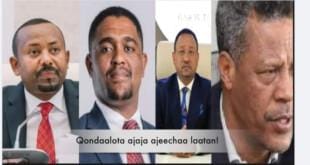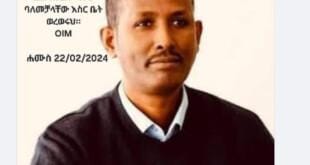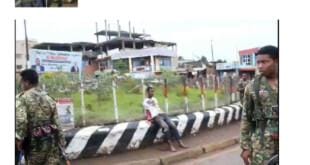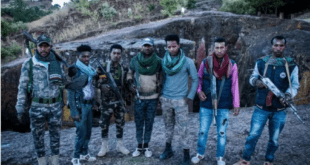It is interesting to observe that nowadays all Oromo from both ideological camps (the pro-independence and the pro-union) are supporting the OFC with similar tone and voice! Because of my last articles, I got a lot of e-mails full of questions, criticisms, protests and “corrections.” The main complaint was that “I am a unionist = Ethiopianist, who systematically opposes the right of the Oromo nation to struggle for Bilisummaa (freedom) and Walabummaa (independence).” Is it really so? Were my hitherto articles as such confusing for people to raise such questions? Here, in this short essay, I want to put my position as clear as possible.
One of the critics was based on the Gadaa.com’s comment, which the publisher once put in the front page of the website: “Get Fayyis’ized, Paradigm Shift Happens.” People understood this as if my position was a “paradigm shift” from the “kaayyoo ganamaa = original goal.” I personally think it is good to get “Fayyis’ized,” but for whom is the shift suggested? If that was meant for the nostalgic unitarists, status quo hegemonists and even for federalists to make a shift towards the lasting solution proposed by the unionists, that is fine. As far as I am concerned, the goal expressed as ‘Union of Free Nations’, is inclusive to the “kaayyoo ganamaa”, i.e to bilisummaa Oromo and walabummaa Oromia. Without national bilisummaa and territorial walabummaa as prerequisites, there will not be any genuine union of nations in the region. So, for the Oromo freedom fighters, there is no necessity of a paradigm shift, but a need to have a
far-sightedness in order to be inclusive in a possible regional union, instead of thinking and talking about only a national liberation.
When we look at the conflict between the states like Somaliland and Puntland or the still existing conflict between Abyssinia and Oromia, we just think that a union of independent nations envisioned by some goodhearted people is yet a distant goal. It suggests that we now better concentrate on the liberation struggle of nations at hand, not on such far-fetched union of nations. There is always a national territorial liberation in a form of walabummaa (independence) between the stages of federation of nations (pre-walabummaa union) and confederation of liberated nations (post-walabummaa union). It is fact on the ground that Oromo nationalists do first struggle for Oromian national liberation (in a form of free Oromia wihin oe without Ethiopia) and then discuss about regional union, be it that of transforming the Abyssinian empire (union per force) to an Ethiopian union (union per free will) or forging the union of nations in the Horn of Africa. NB: The
future union can also be named Oromia instead of Ethiopia based on voluntary decission of the partakers.
When we look back at the hitherto alliances forged by Oromo liberation movements, Medrek is a federalist, ULFO is a liberationist & AFD is a unionist in a true sense. Oromo people need all the three types. We have to support Medrek to come to our next mid-goal (federation); we need tokkummaa for bilisummaa (unity for liberty) of all Oromo liberation movements to secure the very much needed bilisummaa Oromo and walabummaa Oromia; then, we should foster AFD-like unionist alliance to promote a union of all liberated nations in the Horn for our common benefit. To understand what I wrote in my last articles, we should take into consideration the level at which the three very important Oromo organizations do move. The OFC as a federalist party wants to realize Oromian autonomy within Ethiopian context; OLF as a liberation front wants to achieve both freedom of the Oromo people and sovereignty of the Oromo land; the future AFD-like organization as a
supranational alliance in the region can struggle for a union of all the liberated nations. Only if we see how the cascading of this Oromo move is leading us to accomplish our Oromo cultural, economic and political interest, then is it possible to comprehend what I have tried to put in my hitherto essays.
The cascade/spectrum of the politicians in the empire (when put it in line) is as follows:
– Unitarists (past oriented)
– Hegemonists (present rulers)
– Federalists (short-goal oriented)
– Liberationists (middle-goal oriented) &
– Unionists (end-goal oriented)
The liberationists like the OLF are not satisfied with only federal arrangement of the federalists like the OFC, but they want to achieve in addition to freedom of nations, e.g freedom of the Oromo people (bilisummaa), also a sovereignty of national areas, e.g sovereignty of Oromo land (walabummaa). Based on their vission, a genuine union of nations can only be imagined after achieving the goal of both national freedom and territorial sovereignty. As an example, only free Oromo people and sovereign Oromo land can forge a union with other liberated nations in the region. Then, we can say that it is not abnormal to see Oromo individuals rallying behind the unitarist Amhara parties, the hegemonist Tigaru organization, the federalist Oromo parties, the liberationist Oromo fronts and the the unionist Oromo organizations. Let’s just register this fact, teach those Oromo individuals rallying behind the unitarists as well as the hegemonists to stop their
madness and then move on to achieve the three consecutive goals we envisioned – federation, liberation and a lasting union – one after another.
According to the line of the liberation journey I described till now, it is as follows: from the past unitary empire —— through the present occupied Oromia —— first to Oromian autonomy —— then to Oromian independence —— and at last to a regional union of liberated nations in the Horn, which can also be called Oromian union. My hitherto writings seem to be confusing for I sometimes emphasized the true federation to realize Oromian autonomy; sometimes stressed bilisummaa Oromo and walabummaa Oromia to secure an independence on which we all Oromo seem to make no compromise; and, of course, sometimes I used to talk about the regional union of independent (liberated) nations. Those who understand this line of thinking can comprehend my opinions well. Let us forget the past-oriented momentarily powerless Habesha unitarists; fight against the presently ruling powerful Habesha hegemonists; and let us concentrate on the Oromo movement in our
future journey. Here, according to the line I put above, there are three Oromo forces: the autonomists (federalists) who want to be satisfied with Oromian autonomy in the Ethiopian context, e.g the OFC; the sovereigntists (liberationists) stressing to build only independent republic of Oromia, e.g the OLF; and the unionists, who do want to move beyond independence and forge a union of independent nations, e.g the Ex-AFD. My hitherto job was to show that these three kaayyoo’s are not contradictory, but they are like three cities to be liberated one after another on our liberation journey. I gave the metaphor of the liberation journey from Djibouti (grbummaa/colony) to Finfinne (lucrative bilisummaa/freedom): Oromian autonomy is like liberating Diredhawa; achieving only Oromian independence is like liberating Adaama; and fostering Oromian national independence with a regional union of independent nations in the Horn is like liberating Finfinne (the most
advantageous form of our sovereignty). With this help, I hoped that all Oromos in the walk of life could move together first to Diredhawa, then together to Adaama and lastly together to Finfinne.
As I repeatedly put, the politics of the empire is rotating around the issue of national rights. To me, the conflict in the empire is not about left (socialist) and right (capitalist) based on the policy each party has got regarding economy. It is also not about the differences of positions based on the merits like democracy, justice, peace, development, security, etc. The main cause of the conflict in the empire is because of the position every individual or organization has got on the ‘right of nations to self-determination.’ That is why I used the above mentioned cascade/spectrum to classify the polity in the empire. I don’t want to describe again what the positions of these groups are, but important is to tell my position explicitly: I AM UNIONIST. I know that the end-kaayyoo/goal of Oromo nation is self-determination per referendum on the issue: independence within a union vs independence without a union. I personally do prefer independent
Oromia within regional union of free nations, be it the union includs or excluds Abyssinia. That is why I am ready to move with federalist Oromo one step forward, with liberationist Oromo two steps forward and then get to the lasting beneficial kaayyoo I do want to achieve (independent Oromia within a union of free nations). It is clear I am against unitarists and hegemonists, but I do see the federalists and liberationists as my co-travelers up to Diredhawa and Adaama, respectively. At last, I would like that they move with me to Finfinne, but if they want to stay in Diredhawa or Adaama, I do respect their position, if and only if they don’t use force to hinder my move to Finfinne. Of course, Oromo people will determine per referendum, whether we all stay together in Adaama (achieve only independent Republic of Oromia) or we move further to Finfinne (foster independent Oromia with a union of free nations).
Here again, I need to take care that my position may not be confused with being Ethiopianists in true sense. I think people need to understand the difference between pre-walabummaa union and post-walabummaa union. The first one is what is said to be a union of federated nations before the independence of nations in the United Nations. The second one is the union like EU (European Union) after getting their independence. The union I do support is the union of independent nations (post-walabummaa union). The future move of Oromo sovereignty will be first to a union of federated nations (federation = pre-walabummaa union = a move to Diredhawa) —— then to walabummaa Oromia (= a move to Adaama) —— at last a move to union of liberated (independent) nations (post-walabummaa union = a move to Finfinne). If we all Oromo individuals and organizations divide our goal-setting into these three, then there will never be a confusion among us. We all can support
together the move of the OFC to achieve Oromian autonomy (federation), then we all can support the OLF for further move for Oromian independence (liberation), and, of course, at last we can support organizations like the AFD to forge a regional union of nations in the Horn for common economical benefit. In such case, I did prefer to be a unionist, the goal of which actually does include federation and liberation as the mid-goals to our lasting beneficial goal (union of independent nations). So let’s forget the past-oriented unitarists, but fight now against the present powerful hegemonists by building, strengthening and coordinating the following three alliances functioning at the three goal-levels described above: the OFC’s alliance aka Medrek, who can promote our liberation movement to Diredhawa; the OLF to help us move beyond federation to liberation as a precondition to self-determination per referendum, a move to Adaama; and the future AFD to
lead us to the regional union of liberated nations after independence of each nation in the Horn for our common benefit – a last move to Finfinne.
Then using and coordinating these three alliances/organizations, we can move through the two mid-goals (federation and liberation) to our common goal of all free nations in the Horn to build a prosperous common home. Last, but not least, as I already wrote, ‘self-determination of nations’ is the burning issue in the empire and the region. To my hitherto readings, all the three politically very active main Oromo organizations (the OPDO, the OFC and the OLF) already started to talk about the necessity of a union of free nations in the region. But where is their difference? Here is it: OPDO’s version of a union lacks both bilisummaa Oromo and walabummaa Oromia. OFC’s version promises bilisummaa Oromo, but lacks walabummaa Oromia. OLF’s version promises both bilisummaa Oromo and walabummaa Oromia. Simply put, there is no Oromo who is against a necessary union of liberated nations, but all Oromo individuals and organizations do differ in the content
of the union they want to materialize. Let’s be ready to move from the present union of nations in the empire which is devoid of both bilisummaa and walabumma, first to version of the OFC, and then to that of the OLF. If this opinion of mine is good, then Get Fayyis’ized and move on, but no need of paradigm shift for the unionists like me. May Waaq help us!
Galatooma!




